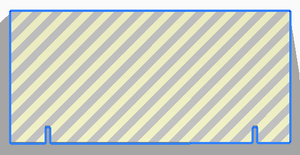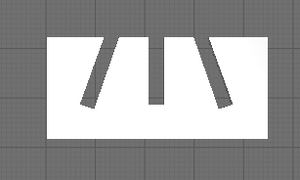 Prototype of low-cost solar cooker made with cardboard and aluminum materials.
Prototype of low-cost solar cooker made with cardboard and aluminum materials.This page presents the design and manufacturing process of a low-cost solar cooker.
Contents
Project description
The solar cooker represents an innovative project due to the reduced costs involved. Thus, a social aid movement is promoted, where these models are supplied to low-income families, eliminating their dependence on gas or firewood.
Due to its simplicity, portability and ease of efficient use, this model increases the advantages and comparative difference with other models. In addition, to ensure the use of these features, a simplified manual and graphic for assembly and correct use are included.
Bibliographic review
Initially, the project is based on the Appropedia blog “Solar Cooker” and “Efficiency analysis of a solar cooker”, which instruct on factors of interest such as solar distribution, solar exposure, efficiency analysis and other relevant and worthy areas. study.
- Efficiency analysis of a solar cooker - Appropedia, the sustainability wiki. (n.d.). https://www.appropedia.org/Efficiency_analysis_of_a_solar_cooker
- Solar cooker - Appropedia, the sustainability wiki. (n.d.). https://www.appropedia.org/Solar_cooker/es
Once these factors are defined, “Solar cooker designs” and “Solar box cooker research project” are taken to define possible models of interest. Added to this, with a view to minimizing costs and simplifying efficient use, the boxed solar cooker model is selected.
- Solar cooker designs | Solar Cooking | Fandom. (n.d.). Solar Cooking. https://solarcooking.fandom.com/wiki/Category:Solar_cooker_designs
- Solar box cooker research project - Appropedia, the sustainability wiki. (n.d.). https://www.appropedia.org/Solar_box_cooker_research_project
Finally, with the model and theory defined, it is based on the blog “How to make a homemade solar cooker, very simple!” to define a tentative action plan and a possible list of materials.
- Crespo, C. (2018, July 19). How to make a homemade solar cooker, very simple! - PortalFruticola.com. PortalFruticola.com, https://www.portalfruticola.com/noticias/2018/07/19/como-hacer-una-cocina-solar-casera-y-muy-sencilla/
Design description (how it works, physical characteristics)
With special care in the model and its operation, the solar cooker is made up of a mobile box. In addition, the two side walls have three pairs of slits at different angles to regulate the angle and maximize efficiency.
Additionally, on the side of the base and at the bottom of the lid, there are different holes where the regulating rod fits to be able to move the lid. How to know the necessary angle? On one side of the base, in each hole, there will be the times of day printed, which indicate where the rod should be according to the time and geographical position of El Salvador.
The box will be lined in aluminum foil. This will allow it to maintain heat after sun exposure, in case you want to store food for longer and maintain the temperature and ensure the reflection of the sun's rays on the base and lid of the box.
List of materials, tools and manufacturing processes
In general, the production of this model is simple, since that was the objective of the project. This only involves:
- Sheets of wood (or a pre-assembled box)
- Aluminum
Of these, for the manual implementation of this tool they are summarized as follows:
| Material | Measures | Cost | Reference |
|---|---|---|---|
| Melamine solid wood | 0.36 m^2 | $5.56 | https://sv.epaenlinea.com/lamina-melaminica-nogal-16-mm.html |
| Foil | 0.36 m^2 | $1.29 | https://www.superselectos.com/Tienda/Buscador?keyword=aluminio |
With total costs of $6.85 for each functional and operable solar cooker. The operability of this model made with common materials (without laser cutting) is indicated, since this is how it was made for testing by the team.
However, the final design can be replicated with laser cutting using the files. It is worth mentioning that with this option the costs increase, but at the same time the finishes and resistance (durability) also increase.
| Material | Measures | Cost |
|---|---|---|
| laser cutting for box | 0.36 m^2 | $10.50 |
| Foil | 0.36 m^2 | $1.29 |
With a total cost of 11.79, which is 72% more than with conventional construction.
In addition to this, shipping costs are taken into account. These are variables, but, for example, when purchasing all the materials at EPA (which are available), shipping would amount to around $25.00 to the Canton of El Matazano through couriers, which is unfeasible. Given this, it is recommended to make physical purchases in stores, reducing transportation costs to no more than $5.00 by public transportation. This exit is viable due to the mobility of the disassembled box.
Manufacturing Files
The manufacturing files that have been arranged below in the gallery are called "Flat cook fusion flat model layout", "Solar cook - fusion flat model v1 svg format" and "Solar cook - fusion flat model v1".
For the latter, the link is added below, since it is not possible to view it on all devices: File:Solar cook - fusion flat model v1.stl
Assembly instructions
Our prototype
Collect a box with a lid (shoe box, for example), aluminum foil, insulating tape, a sheet of cardboard.
Cover the box and the panels with aluminum foil.
Place the box in a space where the sun reaches.
Place the panels on the sides of the box with their respective bases.
Final product
- Download the files of the solar cooker parts.
- Send the files to print with a laser cutter.
- Assemble the box and panels
- Cover the box and panels with aluminum foil
- Place the box in a space where the sun reaches.
Place the panels on the sides of the box with their respective bases.
Operating instructions
The box-type solar cooker is a large oven that is covered in aluminum to trap and reflect the sun's rays. To counteract heat loss, two side panels are included that reflect sunlight and increase the amount of heat that reaches the interior of the oven. The box is placed so that the lid reflects the sun's rays into the box, and the panels do the same. Then we placed the pot with the water, waited for it to heat up a little to add the egg. Finally, we waited 30 minutes for it to cook.
As a safety recommendation, we recommend not touching the pot with your hands, always using gloves, or holding the plastic parts.
Conclusions and recommendations
As a team we concluded that, although it is a more time-consuming way of cooking, it is possible and feasible. It is important to learn the cooking time, since it is different from the time in a day-to-day kitchen. In terms of costs, it is quite affordable, even more so when compared to the average price of a gas stove. However, it should be noted that there is always the risk that the day will not be sunny enough to cook.
It is advisable to use a dark-colored pot or saucepan for cooking, as it absorbs as much heat as possible and allows higher temperatures to be reached. Also, it is recommended to use transparent lids to avoid heat loss when trying to lift it to see how the food is cooking.
References
- Solar oven (box type oven) - Low-tech Lab . (n.d.). https://wiki.lowtechlab.org/wiki/Four_solaire_(cuiseur_type_bo%C3%AEte)/es
- Solar box cooker research project - Appropedia, the sustainability wiki . (n.d.). https://www.appropedia.org/Solar_box_cooker_research_project





